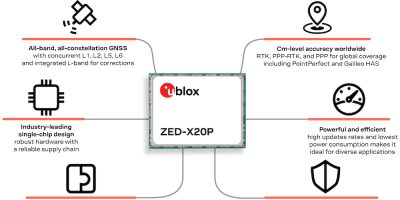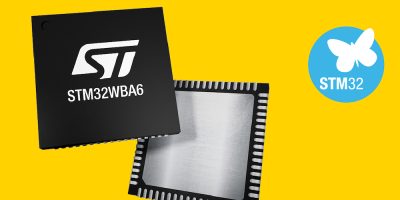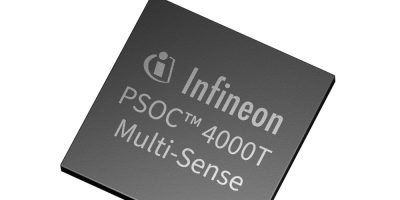u-blox has announced the launch and availability of its all-band GNSS module, the ZED-X20P. Designed to deliver global, centimetre-level location precision to the mass market, all at a total cost up to 90% less than traditional solutions.
The ZED-X20P breaks down the technological and cost barriers to put worldwide, cm-level navigation capabilities within reach for numerous applications for the first time.
The compact ZED-X20P is aimed primarily at the industrial sector, including smart construction, surveying, precision agriculture, rail, maritime, mining, and deformation monitoring. Other potential use cases include unmanned aerial vehicles (UAVs), ground robotics, delivery robots, smart cities, and virtual reality.
The u-blox ZED-X20P is designed for global use at scale. It can receive concurrent signals on the L1, L2, L5, and L6 bands from four global GNSS constellations, as well as SBAS, QZSS, and NavIC.
To achieve high-precision positional information, the ZED-X20P is compatible with a range of GNSS correction services, including those delivered via satellite through L-band, with no extra hardware required. Customers can choose u-blox’s PointPerfect, which offers a full range of PPP-RTK, network RTK, and global PPP correction services for solid performance and scalability to mass-market solutions. The module also offers built-in support for Galileo E6, meaning customers will have access to the free-to-use Galileo High Accuracy Service (HAS), as well as any standard-compliant RTK service, including free and commercial options, for maximum flexibility.
When paired with an all-band antenna such as the u-blox ANN-MB2, the ZED-X20P ensures optimal results, combining ease of use with superior compatibility. Together, they create a one-stop-shop solution for achieving affordable high precision across a diverse array of applications.
Security and ease of integration
With location data integrity being critical to many of the ZED-X20P’s target applications, the module is designed with end-to-end security to safeguard the navigation information the host equipment receives by protecting one of the most important sensors in the end device.
Security measures include secure boot and signed firmware to prevent tampering and a built-in root of trust for securely storing cryptographic material. The module supports Galileo OSNMA (Open Service Navigation Message Authentication) and uses encrypted correction data to enhance security further. It features all-band frequency diversity, which provides robust protection against jamming. Additionally, all communications between the module and the host are encrypted and authenticated, ensuring secure data transfer.
The ZED-X20P is also designed for ease of integration into new and existing products. Combining all positioning functionality into a single compact module that incorporates the all-band receiver chip and correction data processing eliminates the need for additional receivers or on-host processing. Moreover, by retaining the popular ZED form factor, the module offers an easy upgrade path for existing customers, including those using the ZED-F9P.







